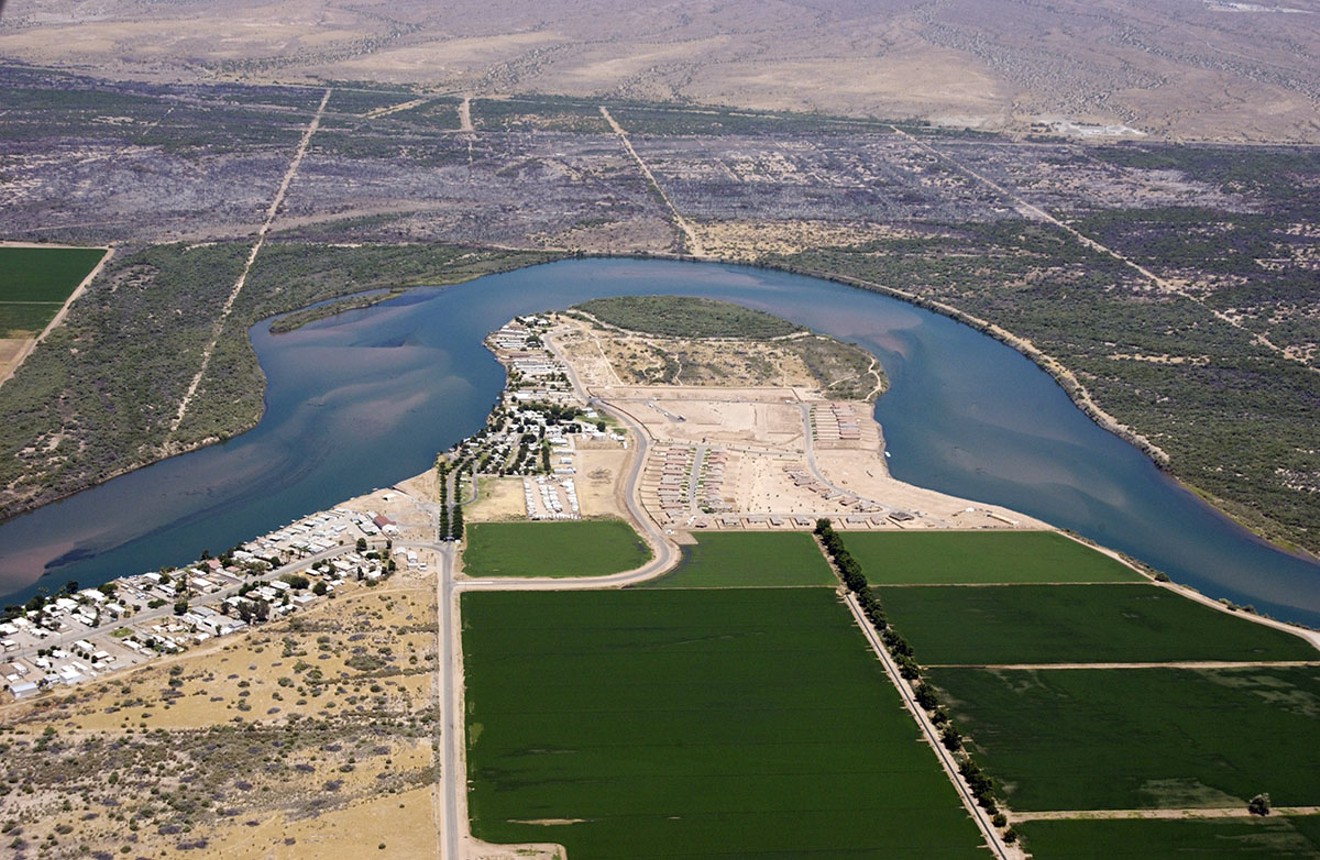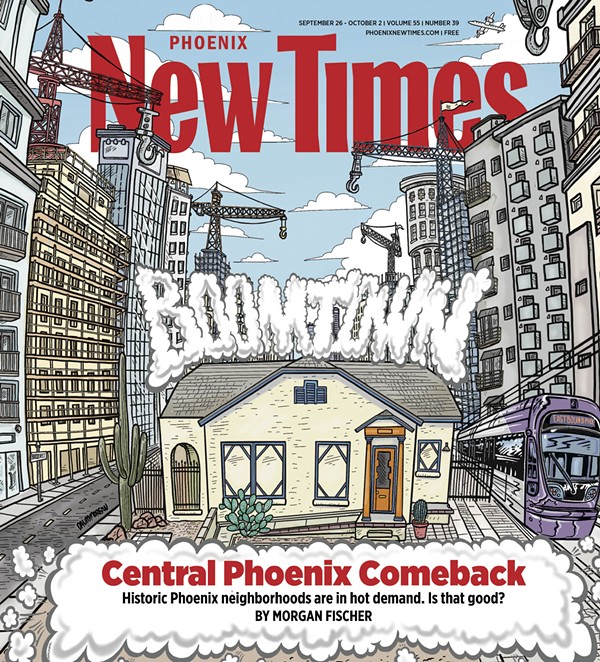The board of the Central Arizona Water Conservation District moved forward Thursday with a fresh proposal to compensate Arizona’s water users for cuts to their supply of Colorado River water under a Drought Contingency Plan.
That proposal, intended to renew lagging DCP talks, was a bare-bones version that board members said they did not expect everyone to agree with. Nevertheless, they authorized Board President Lisa Atkins and Director Karen Cesare to present it to the next DCP Steering Committee meeting on November 29. Arizona had hoped to agree on a drought contingency plan by then, before meeting with California and Nevada officials in mid-December to discuss a broader Lower Basin DCP.
"We believe we can be a catalyst for moving forward quickly and getting DCP across the finish line for Arizona," Ted Cooke, the general manager for the Central Arizona Project and a co-chair of the DCP Steering Committee, said. "We need to be judicious about what additional features we add and how much time that will introduce into the process.”
Cooke said that the complexities of the plan could be worked out later, after a Drought Contingency Plan had been agreed upon by other states, passed by the Arizona legislature, and approved by Congress.
Cooke also said that his foremost concern was the cost of water: "What's this going to do to our rates? I know that’s very important to our customers,” he said. He presented graphs showing that CAP's fixed rates would increase if its water deliveries to customers decreased, as would occur without mitigation.
The seven Colorado River states are developing a DCP because an ongoing drought, now in its 19th year, is on track to worsen sooner than existing drought guidelines can accommodate.
Those guidelines, passed in 2007, were supposed to last until 2026. But Lake Mead, the reservoir on the Colorado River that supplies Arizona, Nevada, and California, has been given a 57 percent chance of falling into shortage in the year 2020. The DCP is supposed to be a six-year plan bridging the years 2020 to 2026.
During the meeting's public comment period, representatives of other Arizona water users focused on several concerns. One was the new proposal's reliance on intentionally created surplus (ICS) water sitting in Lake Mead. Another was the question of whether the latest plan was fair.
Like money in a savings account, ICS water has been stored by states in Lake Mead, with the idea that keeping it in the reservoir could help stave off shortage, which is declared when the reservoir's level dips below 1,075 feet above sea level.
The ICS program, created by interim drought guidelines in 2007, allows states to pull that water out of the reservoir in the future, as long as no shortage has been declared.
The CAWCD board's $36 million to $54 million proposal would cover three years. It would compensate users in the Non-Indian Agriculture (NIA) pool — mainly tribes and cities — 100 percent for their losses under a DCP. It would also compensate agriculture and developers for their cuts. For farmers, it promised to provide them with the 595,000 acre-feet of water through 2026 that the sector has been seeking.
To compensate these users, the proposal suggested pulling up to 400,000 acre-feet of water out of Lake Mead. To many participants in the DCP talks, who attended Thursday's meeting, that sourcing was a problem, because that would mean using Lake Mead to compensate Arizona water users for reductions to their water supply from... Lake Mead.
"The CAP proposal in its current form does not conform to the state of Arizona’s guiding principles,” Tom Buschatzke, the director of the Arizona Department of Water Resources and the other co-chair of the Steering Committee, told the board Thursday. "The state wants to continue discussing the proposal and other proposals to synthesize the meritorious elements of each one, into a package acceptable to all."
He pointed out that the proposal did not align with several principles for any DCP plan laid out by Governor Doug Ducey in an opinion article in the Arizona Capitol Times on Tuesday. Among them were that water must be left in Lake Mead, not taken out.
Governor Stephen Roe Lewis of the Gila River Indian Community echoed that point in his remarks. He reiterated a point the Community has made before — that it was "strongly opposed" to using water from Lake Mead, including ICS water, unless offset by other contributions to the reservoir. Mitigating cuts with other sources of water would raise costs, but that was something the Community was prepared for.
“Rates will have to go up, because DCP will have to become the new normal, and it is best to transition to that new reality sooner than later," Lewis said.
Lewis reiterated, too, that the water cuts had to be shared equitably and fairly. "DCP cannot be used as subsidy for one affected group," he said.
The Arizona agricultural sector seeks compensation of 595,000 acre-feet of water from 2020 to 2026, which many other stakeholders see as unfair, given that farmers would fare better with mitigation under DCP cuts than without. These stakeholders also point out that farmers gave up their legal contract to Colorado River water in a 2004 settlement.
Still, the agricultural sector pushed back against calls for equity and criticized the CAP plan.
“I'm disappointed that there are still some folks who think that is too much for agriculture," said Paul Orme, general counsel for Pinal County agriculture districts. He argued that although agriculture interests had been trying to find ways to use groundwater instead of surface water from the Colorado River, the expectation of farmers had been that they would not have had to figure that out until 2031.
"Now we see we have to do it eight years earlier, and frankly, we need some help,” Orme said.
Bas Aja, a lobbyist for agricultural interests, tried to draw a distinction between equity in priorities and contractual agreements, and equity in the impact of cuts. "There's no equity in impact in these proposals," he said.
Despite these disagreements, during its meeting, the board added an important clause to the initial proposal, agreeing to "continue to negotiate a mitigation plan" within the general parameters of that proposal.
"It could’ve been a lot worse, but we believe that the flexibility demonstrated by the board changed the course of the dialogue and makes a successful outcome still possible," Don Pongrace, an attorney for the Gila River Indian Community said after the meeting. That flexibility, he said, meant "we are close to having a formula for success in a Lower Basin DCP. It will entail some additional work, some additional sacrifice, but not a lot of time."
A week earlier, when CAWCD scheduled its special board meeting, negotiations for a DCP plan stood at an impasse. But private talks since then, and Thursday's proposal, suggest that perhaps there is renewed momentum.
"We are very close, I believe, to a path forward... for DCP that represents and that respects all of the big tent of stakeholders in Arizona," Lewis said in his public comments on Thursday.
"Even in the few days since this meeting was posted ... there have been a lot more discussions that things have changed somewhat, and it’s in a good direction," said Cooke, of the Central Arizona Project, during his presentation.
Cynthia Campbell, water advisor for the city of Phoenix, said that the new CAP plan had some "fundamental issues" in its use of ICS. "It doesn’t seem to make a lot of sense to us," she said. "We think that there have been other discussions going on of other ways to do it, and that today’s action represents the board being expedient. This is the 'easy button.'"
"Kudos to them that they’re trying to put a proposal forward," Campbell added, "But we think that we can still do a little bit better to help protect Lake Mead."

Audio By Carbonatix
[
{
"name": "Air - MediumRectangle - Inline Content - Mobile Display Size",
"component": "18478561",
"insertPoint": "2",
"requiredCountToDisplay": "2",
"watchElement": ".fdn-content-body",
"astAdList": [
{
"adType": "rectangle",
"displayTargets": "mobile"
}
]
},{
"name": "Editor Picks",
"component": "16759093",
"insertPoint": "4",
"requiredCountToDisplay": "1",
"watchElement": ".fdn-content-body",
"astAdList": [
{
"adType": "rectangleLeft",
"displayTargets": "desktop|tablet"
},{
"adType": "rectangleRight",
"displayTargets": "desktop|tablet|mobile"
}
]
},{
"name": "Inline Links",
"component": "17980324",
"insertPoint": "8th",
"startingPoint": 8,
"requiredCountToDisplay": "7",
"maxInsertions": 25
},{
"name": "Air - MediumRectangle - Combo - Inline Content",
"component": "16759092",
"insertPoint": "8th",
"startingPoint": 8,
"requiredCountToDisplay": "7",
"maxInsertions": 25,
"watchElement": ".fdn-content-body",
"astAdList": [
{
"adType": "rectangleLeft",
"displayTargets": "desktop|tablet"
},{
"adType": "rectangleRight",
"displayTargets": "desktop|tablet|mobile"
}
]
},{
"name": "Inline Links",
"component": "17980324",
"insertPoint": "8th",
"startingPoint": 12,
"requiredCountToDisplay": "11",
"maxInsertions": 24
},{
"name": "Air - Leaderboard Tower - Combo - Inline Content",
"component": "16759094",
"insertPoint": "8th",
"startingPoint": 12,
"requiredCountToDisplay": "11",
"maxInsertions": 24,
"watchElement": ".fdn-content-body",
"astAdList": [
{
"adType": "leaderboardInlineContent",
"displayTargets": "desktop|tablet"
},{
"adType": "tower",
"displayTargets": "mobile"
}
]
}
]











